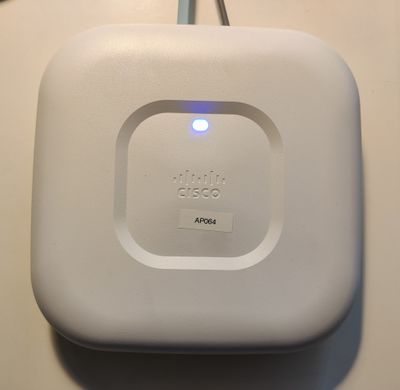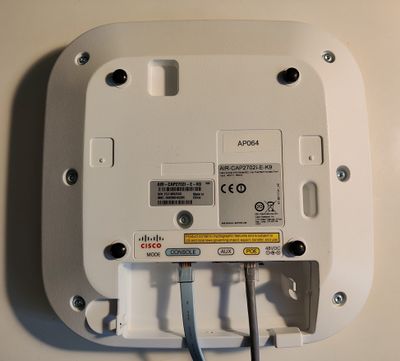Difference between revisions of "Cisco Air-CAP-2702O-E-K9"
Carroarmato0 (talk | contribs) (→Creating SSID | Authentication | Apply WPAv2) |
Carroarmato0 (talk | contribs) |
||
| (7 intermediate revisions by the same user not shown) | |||
| Line 3: | Line 3: | ||
== Specifications == | == Specifications == | ||
| − | Vendor: Cisco | + | '''Vendor''': Cisco |
| − | Model: Aironet 2700 Series 802.11ac Dual Band Access Point | + | '''Model''': Aironet 2700 Series 802.11ac Dual Band Access Point |
| − | Part Number: AIR-CAP2702I-E-K9 v03 | + | '''Part Number''': AIR-CAP2702I-E-K9 v03 |
| − | System Memory: | + | '''System Memory''': |
* 512 MB DRAM | * 512 MB DRAM | ||
* 64 MB flash | * 64 MB flash | ||
| − | Power Draw: 15W | + | '''Power Draw''': 15W |
| − | Interfaces: | + | '''Interfaces''': |
* 2x10/100/1000BASE-T autosensing (RJ-45) | * 2x10/100/1000BASE-T autosensing (RJ-45) | ||
* Management console port (RJ-45) | * Management console port (RJ-45) | ||
| − | CPU: PowerPC CPU at 800Mhz, revision number 0x2151 with 376814K/134656K bytes of memory | + | '''CPU''': PowerPC CPU at 800Mhz, revision number 0x2151 with 376814K/134656K bytes of memory |
| − | Console: 9600 8N1, Hardware Flow Control = no, Software Flow Control = no | + | '''Console''': 9600 8N1, Hardware Flow Control = no, Software Flow Control = no |
| + | |||
| + | '''Network specs''': | ||
| + | * Radio0: 802.11n 2.4GHz | ||
| + | * Radio1: 802.11ac 5GHz | ||
| + | * Max speeds on 5GHz: ~150 Mbps | ||
| + | * Data Transfer Rate: 450 Mbps | ||
| + | * Line Coding Format: CCK | ||
| + | * Data Link Protocol: IEEE 802.11b, IEEE 802.11a, IEEE 802.11g, IEEE 802.11n, IEEE 802.11ac | ||
| + | * Features: Auto-sensing per device, power over Ethernet (PoE), DFS support, Wi-Fi Multimedia (WMM) support, CleanAir technology, Maximum Ratio Combining (MRC), ClientLink 2.0 technology, 3T4R MIMO technology | ||
| + | * Encryption Algorithm: AES, TLS, PEAP, TTLS, TKIP, WPA, WPA2 | ||
| + | * Authentication Method: MS-CHAP v.2, Extensible Authentication Protocol (EAP), EAP-FAST | ||
| + | * Compliant Standards: IEEE 802.11b, IEEE 802.11a, IEEE 802.3af, IEEE 802.11d, IEEE 802.11g, IEEE 802.1x, IEEE 802.11i, Wi-Fi CERTIFIED, IEEE 802.11h, IEEE 802.11n, IEEE 802.11ac | ||
| + | * Antenna: Omnidirectional, Internal, Gain 4dB | ||
| Line 100: | Line 113: | ||
Once the Access Point is booted, you could enable the Web Server for managing it that way, however it's pretty crap. | Once the Access Point is booted, you could enable the Web Server for managing it that way, however it's pretty crap. | ||
| − | == Enable the Web Interface == | + | == Basic Operations == |
| + | === Enable the Web Interface === | ||
<pre> | <pre> | ||
ap> enable | ap> enable | ||
| Line 115: | Line 129: | ||
</pre> | </pre> | ||
| − | == | + | === Wifi Configuration === |
| − | === Creating SSID | Authentication | Apply WPAv2 === | + | ==== Creating SSID | Authentication | Apply WPAv2 ==== |
<pre> | <pre> | ||
cisco-ap> en | cisco-ap> en | ||
| Line 130: | Line 144: | ||
</pre> | </pre> | ||
| − | === Enable Encryption on Radio | Apply SSID on Interface | Enable Radio === | + | ==== Enable Encryption on Radio | Apply SSID on Interface | Enable Radio ==== |
<pre> | <pre> | ||
| − | cisco-ap(config)# interface dot11radio # | + | cisco-ap(config)# interface dot11radio # # { 0: 2.4GHz, 1: 5GHz } |
cisco-ap(config-if)# encryption mode ciphers aes-ccm # Enable Cipher AES-CCM Encryption on interface | cisco-ap(config-if)# encryption mode ciphers aes-ccm # Enable Cipher AES-CCM Encryption on interface | ||
cisco-ap(config-if)# ssid 0x20 # Enable SSID on Interface | cisco-ap(config-if)# ssid 0x20 # Enable SSID on Interface | ||
cisco-ap(config-if)# channel dfs # Enable DFS (only for 5GHz Radio) | cisco-ap(config-if)# channel dfs # Enable DFS (only for 5GHz Radio) | ||
cisco-ap(config-if)# channel least-congested # Select channel type (2.4GHz Radio) | cisco-ap(config-if)# channel least-congested # Select channel type (2.4GHz Radio) | ||
| − | cisco-ap(config-if): world-mode dot11d country-code BE both # Select country code operation | + | cisco-ap(config-if): world-mode dot11d country-code BE both # Select country code operation |
cisco-ap(config-if): no shutdown | cisco-ap(config-if): no shutdown | ||
</pre> | </pre> | ||
Latest revision as of 13:52, 16 May 2021
Contents
Specifications[edit]
Vendor: Cisco
Model: Aironet 2700 Series 802.11ac Dual Band Access Point
Part Number: AIR-CAP2702I-E-K9 v03
System Memory:
- 512 MB DRAM
- 64 MB flash
Power Draw: 15W
Interfaces:
- 2x10/100/1000BASE-T autosensing (RJ-45)
- Management console port (RJ-45)
CPU: PowerPC CPU at 800Mhz, revision number 0x2151 with 376814K/134656K bytes of memory
Console: 9600 8N1, Hardware Flow Control = no, Software Flow Control = no
Network specs:
- Radio0: 802.11n 2.4GHz
- Radio1: 802.11ac 5GHz
- Max speeds on 5GHz: ~150 Mbps
- Data Transfer Rate: 450 Mbps
- Line Coding Format: CCK
- Data Link Protocol: IEEE 802.11b, IEEE 802.11a, IEEE 802.11g, IEEE 802.11n, IEEE 802.11ac
- Features: Auto-sensing per device, power over Ethernet (PoE), DFS support, Wi-Fi Multimedia (WMM) support, CleanAir technology, Maximum Ratio Combining (MRC), ClientLink 2.0 technology, 3T4R MIMO technology
- Encryption Algorithm: AES, TLS, PEAP, TTLS, TKIP, WPA, WPA2
- Authentication Method: MS-CHAP v.2, Extensible Authentication Protocol (EAP), EAP-FAST
- Compliant Standards: IEEE 802.11b, IEEE 802.11a, IEEE 802.3af, IEEE 802.11d, IEEE 802.11g, IEEE 802.1x, IEEE 802.11i, Wi-Fi CERTIFIED, IEEE 802.11h, IEEE 802.11n, IEEE 802.11ac
- Antenna: Omnidirectional, Internal, Gain 4dB
Entering ROMMON Mode[edit]
ROMmon (ROM Monitor) is a bootstrap program that initializes the hardware and boots the Cisco IOS XE software when you power on or reload a router or other device. If your device does not find a valid system image to load when it is booting, the system enters the ROMMON mode.
- Keep the MODE button pressed while providing the device with power until the LED blinks RED.
Reset Factory Default[edit]
- Enter ROMMON mode
ap: delete flash:/private-multiple-fs Are you sure you want to delete "flash:/private-multiple-fs" (y/n)?y File "flash:/private-multiple-fs" deleted ap: reset Are you sure you want to reset the system (y/n)?y System resetting...
Switch to Standalone Mode[edit]
The Aironets support two modes of operations: Autonomous and Lightweight.
The Lightweight mode is for operating with a central controller, thus not requiring extra components (like a webserver for configuring the device through a webinterface).
The Autonomous mode is a full-blown image with all the necessary stuff to manage the device by itself.
We first need to delete all previously install images as they will make it difficult to boot from the correct firmware image.
Delete all previous images[edit]
Boot normally on the device (if you do not have access, perform the Factory Reset, the default credentials will be Cisco:Cisco).
Once logged in, look for traces of the current firmware, will typically look something like ap3g2-rcvk9w8-mx or ap3g2-k9w8-mx.153-3.JA10:
APd46d.50fa.02bc>en
Password: (Cisco)
Directory of flash:/
2 -rwx 269 Jan 1 1970 00:11:45 +00:00 info
3 -rwx 54810 Jan 6 2020 05:37:36 +00:00 event.log
39 drwx 576 Mar 1 1993 00:05:54 +00:00 ap3g2-rcvk9w8-mx
4 -rwx 0 Mar 1 1993 00:00:34 +00:00 config.txt
5 -rwx 140 Mar 1 1993 00:00:16 +00:00 env_vars
37 -rwx 64 Jan 6 2020 05:37:28 +00:00 sensord_CSPRNG0
15 drwx 2176 Oct 18 2016 12:18:57 +00:00 ap3g2-k9w8-mx.153-3.JA10
71 drwx 320 Mar 1 1993 00:00:15 +00:00 configs
78 -rwx 59679 May 3 2019 07:57:51 +00:00 event.capwap
73 -rwx 64 Jan 6 2020 05:37:28 +00:00 sensord_CSPRNG1
8 -rwx 0 Oct 20 2016 11:17:59 +00:00 ce
7 -rwx 129753 Mar 15 2018 15:03:21 +00:00 event.r1
6 -rwx 1048 Mar 1 1993 00:00:20 +00:00 private-multiple-fs
11 -rwx 128014 Dec 8 2015 19:59:53 +00:00 event.r0
84 -rwx 74 Mar 3 2020 17:59:32 +00:00 capwap-saved-config-bak
87 -rwx 95008 Jun 25 2019 10:26:52 +00:00 lwapp_reap.cfg.bak
APd46d.50fa.02bc# delete /recursive /force flash:/ap3g2-rcvk9w8-mx
APd46d.50fa.02bc# delete /recursive /force flash:/ap3g2-k9w8-mx.153-3.JA10
Switch to Autonomous Mode[edit]
- Prepare a TFTP Server
- The Cisco device will by default use 10.0.0.1 for its IP, therefore, its recommended that you use 10.0.0.10 for your server, but it's not necessary as we can force the device to connect to a specific address.
- The device will expect your firmware tarball to be named something like: "ap3g2-k9w7-tar.default" in your TFTP server root directory. So, if your firmware file is called ap3g2-k9w7-tar.153-3.JPI4.tar, replace everything that comes after the first .tar with .tar.default.
- Go into ROMMON mode
ap: set IP_ADDR 10.0.0.1 ap: set NETMASK 255.255.255.0 ap: tftp_init ap: ether_init ap: flash_init ap: tar -xtract tftp://10.0.0.2/ap3g2-k9w7-tar.default flash: ap: dir flash: ap: set boot flash:/ap3g2-k9w7-mx.153-3.JPI4/ap3g2-k9w7-mx.153-3.JPI4 ap: set ap: boot
Once the Access Point is booted, you could enable the Web Server for managing it that way, however it's pretty crap.
Basic Operations[edit]
Enable the Web Interface[edit]
ap> enable Password: ap# configure terminal Enter configuration commands, one per line. End with CNTL/Z. ap(config)#ip http secure-server % Generating 1024 bit RSA keys, keys will be non-exportable... [OK] (elapsed time was 0 seconds) The default password of Cisco routers usually is either “admin”, “cisco” or the field is simply left blank. ap(config)# end ap# copy run start
Wifi Configuration[edit]
Creating SSID | Authentication | Apply WPAv2[edit]
cisco-ap> en Password: cisco-ap# conf t Enter configuration commands, one per line. End with CNTL/Z. cisco-ap(config)# dot11 ssid 0x20 # Create SSID cisco-ap(config-ssid)# guest-mode # Turn on SSID Broadcast cisco-ap(config-ssid)# authentication open # Allow anyone to connect cisco-ap(config-ssid)# authentication key-management wpa version 2 # Use WPA2 cisco-ap(config-ssid)# wpa-psk ascii unicorns # Set Password cisco-ap(config-ssid)# exit
Enable Encryption on Radio | Apply SSID on Interface | Enable Radio[edit]
cisco-ap(config)# interface dot11radio # # { 0: 2.4GHz, 1: 5GHz }
cisco-ap(config-if)# encryption mode ciphers aes-ccm # Enable Cipher AES-CCM Encryption on interface
cisco-ap(config-if)# ssid 0x20 # Enable SSID on Interface
cisco-ap(config-if)# channel dfs # Enable DFS (only for 5GHz Radio)
cisco-ap(config-if)# channel least-congested # Select channel type (2.4GHz Radio)
cisco-ap(config-if): world-mode dot11d country-code BE both # Select country code operation
cisco-ap(config-if): no shutdown
Show Wifi Associations[edit]
cisco-ap#show Dot11 associations 802.11 Client Stations on Dot11Radio1: SSID [0x20] : MAC Address IP address IPV6 address Device Name Parent State 0a1b.6558.0e8d 192.168.50.155 2A02:1812:1603:B530:251B:842F:15CA:10EBunknown - self Assoc

